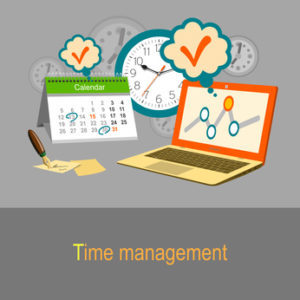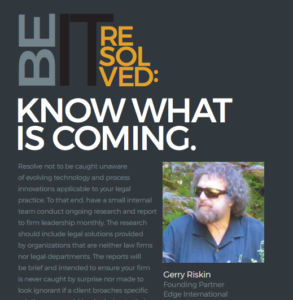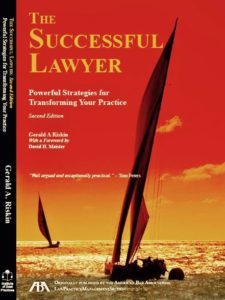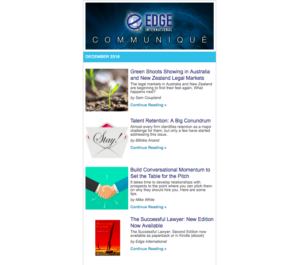Gerald A. Riskin's Blog, page 18
February 2, 2017
Manage Space as Well as Time to Increase Productivity
 An article entitled “10 Simple Productivity Tips for Organizing your Work Life” by David Lavenda, published appropriately early in the new year by Entrepreneur, offers ten tips on improving your work-life productivity.
An article entitled “10 Simple Productivity Tips for Organizing your Work Life” by David Lavenda, published appropriately early in the new year by Entrepreneur, offers ten tips on improving your work-life productivity.
Lavenda points out that all of us have too many things demanding our time and attention, and we need to establish protocols, habits and mindsets that will assist us in using our resources effectively. Although acting on any of Lavenda’s tips is likely to bring positive results, one struck me as particularly useful because most of us rarely think about it: “6. Consolidate the number of places you need to go for information.”
Lavenda points out that it is not only over physical space that we need to gain control in order to work effectively, but also over virtual space. Most of us consult with many apps and platforms during a typical day – from email to databases to social media utilities to our calendars. He suggests that we “Make notifications from each application appear in one place” – using an SMS reader or email subscriptions, for example. This will help us to avoid touring around from one app to another throughout the day, often becoming increasingly distracted as we go.
Let me know your thoughts on this or any other law-related subject, either through the comments below or directly via email.
January 26, 2017
Client expectations: Modify, don’t “manage”
 In my most recent contribution to Edge International Communique (EIC), I argue that working to modify client expectations – rather than merely manage expectations – is a “license to print” client satisfaction.
In my most recent contribution to Edge International Communique (EIC), I argue that working to modify client expectations – rather than merely manage expectations – is a “license to print” client satisfaction.
I encourage you to check out the entire January issue of EIC; in the meantime, here is a summary of my article:
Conventional wisdom says that we should determine client expectations, and then surpass them. However, for a variety of reasons, the expectations of our clients are often flawed in the first place.
In the world of expectations, processes seem to occur almost instantaneously. Clients may think a particular process should take a week, when it might in fact take three weeks… or three months.
When clients think that a process should take only a few days, after a week or two they will think that we have dropped the ball. They may begin to resent us, and have a negative predisposition towards our fee even before the work is done.
A client’s unhappiness is often created by the dissonance between the artificial expectation and the reality, not by the actual reality. Professionals have the opportunity to shape and mold clients’ expectations, making them more realistic.
Problems often begin with a basic, grave misconception: we assume that what we believe and know, others believe and know as well. We need to learn to take advantage of opportunities to modify expectations.
The next time you are in the role of serving someone else, whether a client outside your firm or one of the other professionals within it, take a few moments to explore their expectations, and then help them modify them to fit better with reality, so that the “ruler in their heads” will realistically measure your effort and anticipate the results that are possible to achieve.
If I’m allowed to shape the ruler, I can almost always meet or transcend the expectations of the person in whom that ruler resides. That way I can preclude the outcome of falling short on impossible expectations.
As always, I invite you to let me know your thoughts on this or any other law-related subject, either through the comments below or directly via email.
Note: This article first appeared in a slightly different form on LinkedIn Pulse.
January 19, 2017
Complacency about artificial intelligence: A silent law-firm killer?

AI to replace human managers at Bridgewater Associates – The Guardian
It is tempting for law firm leaders to assume that what they do is simply far too sophisticated to be seriously threatened by artificial intelligence. Anyone feeling complacent on this subject would do well to read a recent Guardian article entitled, “World’s largest hedge fund to replace managers with artificial intelligence” – and then extrapolate to our profession.
OKI grant you that Bridgewater Associates – the hedge fund to which the article refers – has very deep pockets and can invest a fortune in making this initiative work. Even the largest law firms in the world have nowhere near those resources. That said, IBM is underwriting experimentation with AI application with a growing number of law firms. When the offering gets sophisticated enough, I expect it to become pervasive in the legal profession.
The law firms that are participating with IBM’s research are some of the finest firms in the world, including the likes of last year’s global gross revenue leader Latham and Watkins.
I leave you with this thought: Beware of complacency… it could destroy your future.
I welcome your thoughts on this or any other matter related to the law, either in the comments section below or directly via email.
January 12, 2017
Should Managing Partners Structure Their Days like Multimillionaires do?

Screen capture: Larry King talks about his daily routine to Kelsey Humphreys.
In the past two years, Kelsey Humphreys, a contributing writer at Entrepreneur.com, has interviewed successful individuals from a range of fields for her podcast and video series The Pursuit. Her interviewees have included, among many others, real estate mogul and Shark Tank regular Barbara Corcoran, authors Seth Godin and Michael Hyatt, self-help guru Tony Robbins and broadcaster Larry King. From those interviews she has now compiled a brief (7-minute) video in which some of these individuals talk about how they structure their days in order to get their work done, and avoid letting themselves get bogged down and overwhelmed.
Their answers range widely: from putting the kids to bed before starting a night of writing to getting up before anyone else does in the morning. Among the responses, however, there are also common elements. Many remark on the importance they place on looking after their health, and finding quiet times. They all depend on closely structuring their time. Humphries summarizes the common denominators in a brief wrap-up at the end of the video.
For anyone struggling to figure out how to get everything done, given the challenges we all face – family commitments, business meetings, lengthy waits in traffic, etc. – Multimillionaires Share 7 Steps to Structure Your Day for Success may provide some techniques that are worth trying. There is no guarantee they will turn any of us into multimillionaires, but they may make our lives a little more manageable.
As always, I welcome your thoughts, either in the comments section below or directly via email.
January 9, 2017
REGISTER NOW FOR BTI WEBINAR (noon to 1 p.m. ET this Thursday, January 12th)
 BTI’s Market Outlook and Client Service Review 2017
BTI’s Market Outlook and Client Service Review 2017
Attention: Law Firm Leaders and Senior Support Teams:
I strongly recommend you register for this complimentary webinar to be hosted by my much respected friend Michael Rynowecer from noon to 1 p.m. ET on Thursday, January 12.
Here is the information I received from BTI about this webinar (in which you can participate in the comfort of your own office):
Join BTI as we discuss the best new opportunities for 2017, how new client service leaders make it to the top, and how to get ahead of the market in both share and profitability.
The legal market finally is getting exciting again with new and complex work flowing into the market. The hunt for the new opportunities is on. You can find opportunities in practices, industries, and changes in outside counsel management strategies—firms who learn how to find the new work will outperform all others. BTI’s Market Outlook and Client Service Review will help you find—and grab—them before anyone else.
We’ll delve into powerful findings from more than 320 brand new, in-depth interviews with General Counsel—and 16 years of research and experience—to offer a new perspective on what’s in store for 2017. You’ll learn:
• The legal spending outlook for 16 industries and 17 practice areas
• BTI’s exclusive analysis of law firms’ market share gains and losses—expanded for 2017
• With over 50% turnover this year see who makes the brand new BTI Client Service 30—and why
• The new business for the taking—even as corporate counsel shift spending in-house
• The law firms reinventing how legal services are delivered—by name
• What it will take to gain new clients and grow the major clients you have
• And much more…
BTI’s annual webinar attracts more than 1200 law firm leaders worldwide—don’t miss out on your opportunity to discover what the best-performing law firms are doing to stay ahead of the competition in 2017 and beyond.
Registration is complimentary for law firms and BTI clients. Reserve your spot online now or call Joy Harnois at 508.651.5050. (Not a law firm? Call for pricing options.)
January 5, 2017
My Recommendation for Your 2017 Resolution List: Know What Is Coming
 RESOLVE TO KNOW WHAT IS COMING
RESOLVE TO KNOW WHAT IS COMING
Resolve not to be caught unaware of evolving technology and process innovations applicable to your legal practice. To that end, have a small internal team conduct ongoing research and report to firm leadership monthly. The research should include legal solutions provided by organizations that are neither law firms nor legal departments. The reports will be brief and intended to ensure your firm is never caught by surprise nor made to look ignorant if a client broaches specific solutions you could be deploying to their benefit. Firm leadership can decide how to keep all lawyers informed. This is not an idea but rather an action plan and should be treated as such. It is okay to sail into iceberg-infested waters as long as at least one sailor is in the crow’s-nest. – Gerry Riskin
I was pleased to be one of more than twenty “experts, lawyers and professionals who work with lawyers” who were invited by AttorneyatWork to respond to the question, “What is the single resolution you recommend for practicing lawyers in 2017?” The responses were published in an AttorneyatWork post entitled “Be It Resolved: Make the New Year Your Year,” published on December 30, 2016.
“CLICK HERE” TO GET THE DOWNLOADABLE PDF: 22 excellent resolutions in a graphically beautiful format (available for a limited time) that cover a range of topics, (e.g., “Know Your Brand,” “Invest in Your Team,” “Learn to Say No”), each with a brief explanatory note – many of which you can put to work immediately.
In the meantime, let me know your thoughts on this and any other matter related to the law, either in the comments section below or directly via email.
December 20, 2016
Exciting Breaking News – Transatlantic Merger Creates Global Top 40 Giant: Eversheds Sutherland
 On Friday, two major firms I have deeply respected for many years – Eversheds, the global powerhouse based in London, and Sutherland Asbill & Brennan, the exemplary American firm based in Atlanta – announced a merger that changes the multinational legal game.
On Friday, two major firms I have deeply respected for many years – Eversheds, the global powerhouse based in London, and Sutherland Asbill & Brennan, the exemplary American firm based in Atlanta – announced a merger that changes the multinational legal game.
I have known and watched both firms for a long time. Mark Wasserman, long-time managing partner of Sutherland Asbill & Brennan, has been offering great leadership to that wonderful firm for over a decade. In my view, the hook up with Eversheds is a real coup for both firms — “win-win.” Given the sophistication of each firm individually, the combination is going to be a formidable competitor wherever it chooses to practice.
An announcement in Bloomberg’s Big Law Business says that “the deal is expected to create a law firm with more than 2,300 lawyers across 31 offices in 29 countries. It would place the firm among the 40 largest in the world by revenue, with more than $900 million, according to 2015 financial figures in The American Lawyer.” The article reports that the firm will launch on Feb. 1, 2017 under the name Eversheds Sutherland, and will specialize in tax, litigation, financial services, insurance, energy, corporate and real estate.
I offer enthusiastic congratulations to both firms and can not wait to watch this story unfold.
As always, I welcome your thoughts on this and any other matter related to the law, either in the comments section below or directly via email.
December 14, 2016
A THANK YOU offer for subscribers, friends and clients
As a personal THANK YOU to my subscribers and the many lawyers and firms I have served, please accept this offer of a deep discount of my latest book, The Successful Lawyer (Second Edition), at Amazon.
This offer is available from Thursday through Monday (December 15 through 19) ONLY (North American Time).
Paperback version for $19.95 $10.99 US
Kindle version for $7.99 $2.99 US
 I wrote The Successful Lawyer to help lawyers attract more work, reduce stress, and find more enjoyment in the practice of law. Imagine how honoured I was when Tom Peters (author of In Search of Excellence) described The Successful Lawyer as “Well argued and exceptionally practical.”
I wrote The Successful Lawyer to help lawyers attract more work, reduce stress, and find more enjoyment in the practice of law. Imagine how honoured I was when Tom Peters (author of In Search of Excellence) described The Successful Lawyer as “Well argued and exceptionally practical.”
If you own the first edition, published (in hard copy) by the Law Practice Management Section of the American Bar Association, exploit the discount to add the Kindle Second Edition to your personal electronic library accessible on all your electronic devices.
(Please note that the Kindle app is available for all devices at no charge from iTunes or directly from Amazon.)
You may also want to take advantage of this offer to add a paperback copy to your firm library.
Global Discount: Please note that both versions of the book can be ordered at equivalent discounted rates from Amazon locations around the globe.
For more information: See the book’s new website.
Please leave your candid feedback on the Amazon website after you have read the book.
Reminder: This discount is available from Thursday through Monday (December 15 through 19, 2016) ONLY (North American Time):
Paperback version for $19.95 $10.99 US
Kindle version for $7.99 $2.99 US
December 7, 2016
December 2016 Edge International Communiqué now online
 The December, 2016 issue of Edge International Communiqué (EIC) is now posted on the Edge International website.
The December, 2016 issue of Edge International Communiqué (EIC) is now posted on the Edge International website.
The issue opens with an article by Sam Coupland, “Green Shoots Showing in Australia and New Zealand Legal Markets,” which presents some possible reasons for the recent uptick in profitability in legal markets in those countries, and projects what lies ahead.
In “Talent Retention: A Big Conundrum,” Bithika Anand examines the problems associated with the retention of legal talent in India, where competition for human assets is at an all-time high due to the increase in foreign investment, recent governmental policy changes, and widespread talk of economic liberalization. The retention problem is not unique to India, of course, and her suggestions on how to manage this issue make valuable reading for managers at all small- and medium-sized firms.
The issue concludes with Mike White’s latest article, “Build Conversational Momentum to Set the Table for the Pitch.” Mike points out that it is not an effective business-promotion tactic to simply introduce yourself to a prospective client and then launch into your promotional pitch. Instead, effective business builders develop a rapport with prospective clients using graduated steps that gradually move toward the goal of presenting particular their specific talents and expertise, and showing how they will benefit the prospective client.
Each month, EIC publishes items of interest to lawyers around the world on various aspects of law-firm strategy, marketing, technology, management, economics, human relations and a host of other topics. In addition to the most recent edition, the EIC site includes a sign-up page for those who are interested in subscribing to EIC, as well as a list of archived articles.
I welcome your thoughts and feedback on both Edge International Communique and Amazing Firms, Amazing Practices, either in the comments section below, or directly via email.
November 30, 2016
Care about your clients? …let them know.
 After working with thousands of lawyers, I have learned that there is a tremendous gap between the way they perceive their interactions with their clients and how they actually interact.
After working with thousands of lawyers, I have learned that there is a tremendous gap between the way they perceive their interactions with their clients and how they actually interact.
When I ask lawyers if they care about their clients, the answer is almost always a resounding, “Yes.”
The next question I ask is, “Do your clients know you care?”
That question typically receives a puzzled look and then a response something like, “I think so.”
When I then ask, “Why do you think so?” the answers normally have nothing to do with conveying that the lawyer cares. They typically include how hard the lawyer works for the client, including early hours and late evenings, or reductions in fees that the client often doesn’t even know about.
When I press the point by asking “Have you told your client you care?” the answer is almost always the equal of “No.”
Most lawyers are reluctant to show empathy and caring because they feel it will make them look weak or too personal. Nothing could be further from the truth. Empathy and caring can be demonstrated in an assertive way. For example, a lawyer can say, “I can see how frustrated you are at the actions taken by the other side, and I think you’re very much entitled to those feelings. I think you have every right to pursue your position aggressively and I will do everything in my power to get you what I believe you deserve.” (Qualifications can follow from there to manage expectations, but you get the idea.)
A blog post by Ilina Rejeva entitled How Can Empathy Help You Differentiate Your Law Firm? published at LegalTrek argues that empathy can be a strong differentiator. I agree, and I encourage you to read the article.
Let me know your thoughts on this and any other matter related to the law, either in the comments section below or directly via email.



